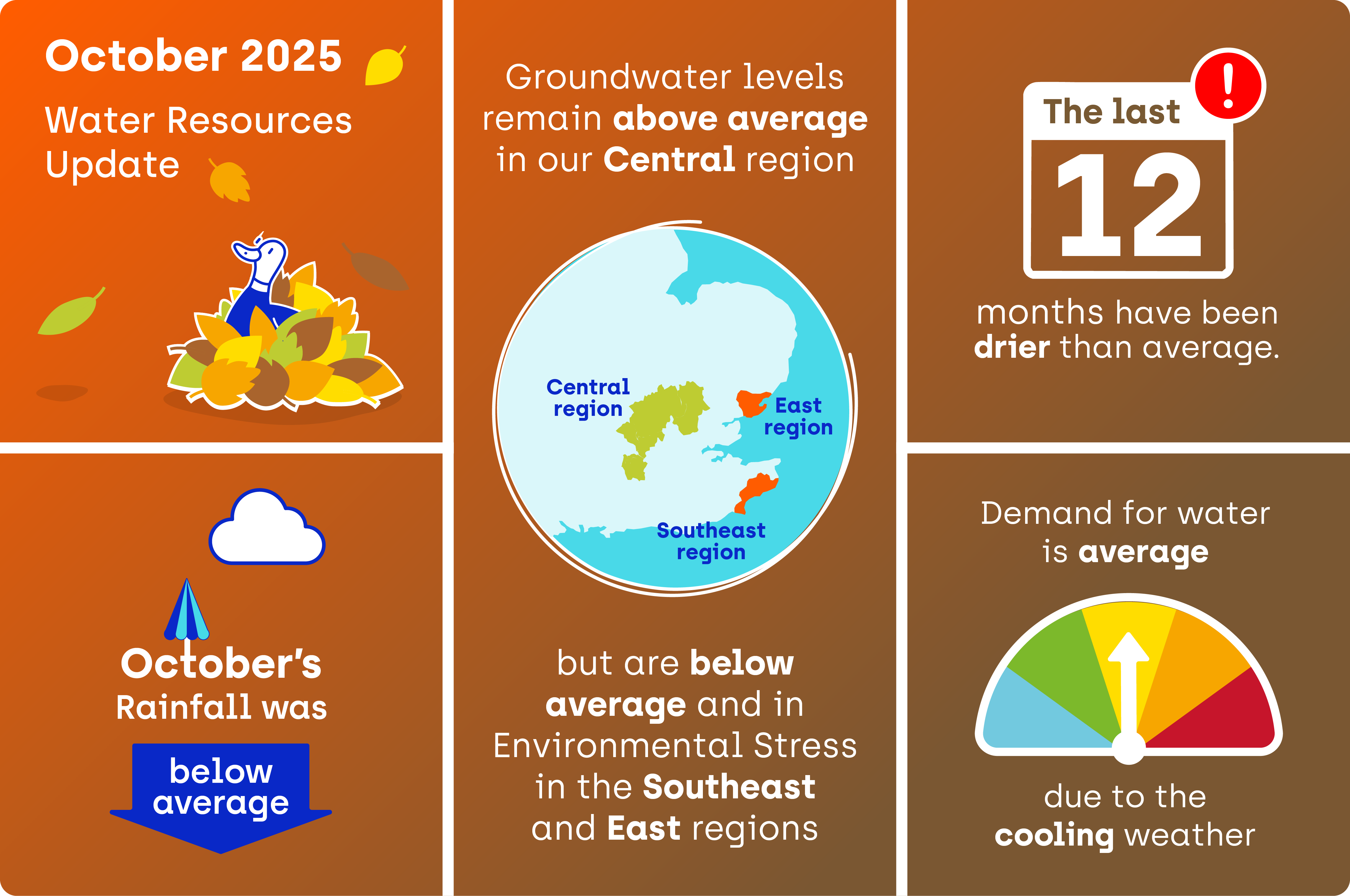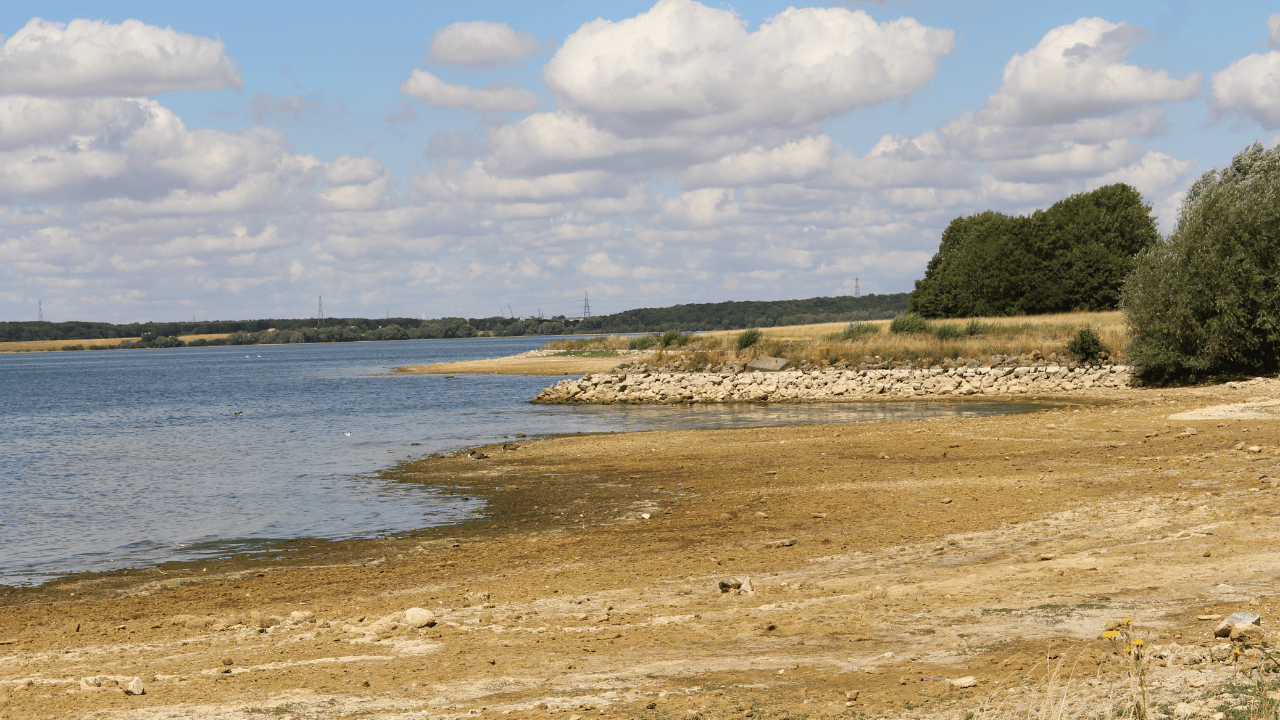With four heatwaves and continued dry weather, this summer was the warmest on record. When the weather hots up, demand for water goes up too, putting extra pressure on our network and the local environment. As a result of this and the dry weather, the water shortfall situation in England has been described as “nationally significant” by the National Drought Group. Even though there’s been more rainfall in September and October, it hasn’t been enough to recharge our water supplies.
Groundwater levels are mostly topped up by rainfall during the winter which supports levels the following summer. If we receive below average winter rainfall, we may need to consider introducing a hosepipe ban next year to help manage demand and protect your supply.

Groundwater levels remain above average in our Central region and below average in our East and South East regions. The East Anglia region has been classified by the Environment Agency as experiencing ‘prolonged dry weather’ and has reached the Environmental Stress trigger outlined in our Drought Management Plan, which is characterised by lack of rainfall and lower than usual river flows.
We've also reached this trigger in the South East region and some of our catchments in the Central region. This is our first drought trigger that lets us know when action should be taken as a result of changing environmental and groundwater level conditions, and is followed by Drought Triggers 1, 2, 3, and 4, which escalate in order of drought severity.
Reservoir levels at Grafham Water - a reservoir that supplies some of our customers – is below average for the time of year. Grafham is owned by Anglian Water. To find out more about Anglian Water’s water resources position, click here.

Picture of Grafham Water in July 2025, courtesy of Anglian Water.
Do you have a hosepipe ban in place?
No – but we’re keeping a close eye on our water resources position and regularly reviewing whether temporary measures, like hosepipe bans, might be needed to make sure we can keep supplying you with water and protect the environment.
A hosepipe ban (Temporary Use Ban) can be brought in when our groundwater levels reach a certain level, or when an extended period of high demand caused by hot and dry weather means we need to implement restrictions to help us conserve supplies.
Let’s work together
We’re doing our bit to find and fix leaks across our network and have reduced leakage by over 19% since 2020, saving 39 million litres of water being lost each day. Our teams are working around the clock, especially during high demand periods, to detect and fix leaks quickly and efficiently.
If everyone uses a little less now, it can help us keep a reliable water supply flowing to all homes and protect our rivers and streams. Making small changes at home, like turning off the tap or using eco settings, can help protect our precious water supply.
Where does our water come from?
Dive into our video below that brings together the full story of your water – from the clouds to our production sites, right through to your taps. Find out where your water comes from, how we collect it responsibly, and get it safely to your home. You’ll see how daily habits affect water use, where used water goes, and how we’re making the process more sustainable.
Frequently asked questions
Can I still use my hosepipe?
Arrow icon
Yes – you can still use your hosepipe. However, we’re asking everyone to use water wisely and conserve supplies, so the use of hosepipes should be avoided where possible. Simple steps to reduce your hosepipe use include using a watering can to water your plants and using a bucket and sponge to wash your car. For more water-saving tips, click here.
Why have other water companies introduced hosepipe bans?
Arrow icon
Droughts affect all water companies differently. Most of the water we supply comes from groundwater sources. Regions that supply more water from surface water sources, such as rivers, streams and reservoirs, are usually affected first in hot dry summers due to less rainfall and more evaporation. Groundwater levels are mostly topped up during the winter which supports levels the following summer/autumn.
Why does demand for water increase in summer?
Arrow icon
Hot, dry weather typically leads to increased outdoor water use, for gardening, filling paddling pools, and car washing. This causes demand to spike, particularly in the morning and early evening, which can lead to low water pressure or supply interruptions because we can’t get water through the pipes quickly enough. If you’re experiencing low water pressure at the moment, please see our alerts page to see if your area is currently affected.
Do you take water from chalk streams?
Arrow icon
We don’t take water directly from chalk streams, but many of our groundwater sources tap into the same aquifer that feeds them. That’s why we’ve made permanent reductions to how much we can take in certain areas, to help protect these rare and sensitive rivers.
How are you reducing the amount of water you take from the environment?
Arrow icon
We’re investing in capital delivery projects where we replace and install new water mains pipes to reduce future leaks and bursts which helps reduce water wastage. Last year we fixed 16,000 leaks and have cut leakage by 19.4% over the past five years – saving 39 million litres of water every day.
By reducing the amount we take, more water is left in the environment. We face many challenges including population growth and climate change and are actively planning to create a secure and environmentally sustainable water supply in the future. For more information about the plans we are putting in place to meet these challenges, please see our Water Resources Management Plan.
We work closely with the Environment Agency to review the sustainability of our abstraction licences and make changes to how we operate when needed. We’ll be monitoring how the environment is responding to keep track of positive changes. We’re committed to helping our environment, now and in the future.